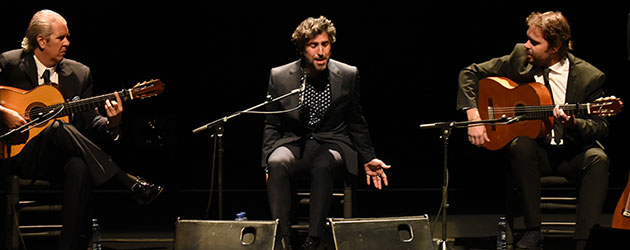Text: Sara Arguijo
Photos: Rocio Cano
The singer gets a standing ovation at the Maestranza Theater for a tribute to the greatest hits of contemporary flamenco in his show «Abecedario Flamenco»
Abecedario flamenco. Voice: Arcángel. Guitars: Miguel Ángel Cortés and Dani de Morón. Percussion: Agustín Diassera. Bass: Pedro Vinagre. Rhythm and chorus: Los Mellis. Chorus: Macarena de la Torre. November 25th, 2017.Teatro de la Maestranza. Full house.
With A. Alfileres de Colores. With B. Buenas Intenciones. With C. Campanas del Alba and Canastera. With D. Dime. With E. El Pequeño Reloj… With S. SOS. With V. Vivo Cielo… Modern Flamenco can run through the entire alphabet with an incredible repertoire of hits that flamenco fans can recite by memory.
Verses, melodies and choruses that tell the most recent history of our art-form in the voices of those who have left their mark on these decades: from Camarón to José Mercé, passing through Diego Carrasco, Mayte Martín, Lole and Manuel or Enrique Morente. Artists who evoke true life experiences in first person. Magical memories steeped in nostalgia, melodies that we seem to hum almost without realizing it.
Nevertheless, when talking about influences, millennial artists are quicker to mention Mairena, Caracol, Chacón and Pastora Pavón than Remedios Amaya, Pansequito, El Pele or El Lebrijano, or any other of above-mentioned. Perhaps due to prejudice. Or out of respect and modesty as Arcángel himself said when explaining the reason for this show which on Saturday was sold out at the Maestranza.
In other words, despite being something thoroughly normal, and even necessary in other genres, in flamenco people have a hard time assimilating something popularized by another. And for this reason, the Huelva singer’s show in which he brings to the stage the most commercial part so to speak, of flamenco’s legacy, is a brave undertaking. “The greatest hits of modern flamenco that many of us have grown up with, and which I bring here, not aiming to correct them, but as a kind of tribute” said the singer.
Nearly two and a half hours in which, despite all the fuss about the letters, which he himself acknowledged, the singer was quite at ease in his goal of personalizing the various tangos, alegrías and bulerías that you could tell he’s sung many times.
In each piece, as we said, Arcángel was able to put his own touch in just the right measure for us to be able to recall the original, but without it seeming like a copy. Thanks in part to his clear natural, dependable weather-worn voice that travels through the verses always seeking other twists and turns. Thanks as well to the fine musicians, from one end of the stage to the other, who afforded new colors and shading to songs that could just as easily have come off as tiresome.
The precision of Los Mellis, the rich voice of Macarena de la Torre, the guitars of Dani de Morón and Miguel Ángel Cortés who, in addition to the alphabet, recited stories, poems and fables full of sensitivity. The good taste and exquisite elegance of a magnificent Agustín Diassera on percussion, “the magician of silence” as the singer calls him, and the most recent addition to the group, Pedro Vinagre who, with his bass, gave just the right tones to make this repertoire sound fresh and new.
Especially interesting were the versions of Lole and Manuel’s Dime, and Mercé’s Aire, although without a doubt, Arcángel had his best moments remembering his maestro, Enrique Morente. Mostly because it was in those pieces that he was more himself, while at the same time, being the other singer. To end, he also took us to Huelva with a string of fandangos at the foot of the stage without amplification, getting the audience to their feet with everyone chiming in with for Alosno niña, vente temprano. Immediately followed by a grand ovation, because cante can no longer be understood without A for Arcángel.
